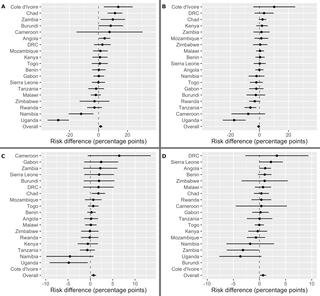Our official English website, www.x-mol.net, welcomes your feedback! (Note: you will need to create a separate account there.)
Drought and intimate partner violence towards women in 19 countries in sub-Saharan Africa during 2011-2018: A population-based study.
PLOS Medicine ( IF 15.8 ) Pub Date : 2020-03-19 , DOI: 10.1371/journal.pmed.1003064 Adrienne Epstein 1 , Eran Bendavid 2 , Denis Nash 3 , Edwin D Charlebois 4 , Sheri D Weiser 4
PLOS Medicine ( IF 15.8 ) Pub Date : 2020-03-19 , DOI: 10.1371/journal.pmed.1003064 Adrienne Epstein 1 , Eran Bendavid 2 , Denis Nash 3 , Edwin D Charlebois 4 , Sheri D Weiser 4
Affiliation

|
BACKGROUND
Drought has many known deleterious impacts on human health, but little is known about the relationship between drought and intimate partner violence (IPV). We aimed to evaluate this relationship and to assess effect heterogeneity between population subgroups among women in 19 sub-Saharan African countries.
METHODS AND FINDINGS
We used data from 19 Demographic and Health Surveys from 2011 to 2018 including 83,990 partnered women aged 15-49 years. Deviations in rainfall in the year before the survey date were measured relative to the 29 previous years using Climate Hazards Group InfraRed Precipitation with Station data, with recent drought classified as ordinal categorical variable (severe: ≤10th percentile; mild/moderate: >10th percentile to ≤30th percentile; none: >30th percentile). We considered 4 IPV-related outcomes: reporting a controlling partner (a risk factor for IPV) and experiencing emotional violence, physical violence, or sexual violence in the 12 months prior to survey. Logistic regression was used to estimate marginal risk differences (RDs). We evaluated the presence of effect heterogeneity by age group and employment status. Of the 83,990 women included in the analytic sample, 10.7% (9,019) experienced severe drought and 23.4% (19,639) experienced mild/moderate drought in the year prior to the survey, with substantial heterogeneity across countries. The mean age of respondents was 30.8 years (standard deviation 8.2). The majority of women lived in rural areas (66.3%) and were married (73.3%), while less than half (42.6%) were literate. Women living in severe drought had higher risk of reporting a controlling partner (marginal RD in percentage points = 3.0, 95% CI 1.3, 4.6; p < 0.001), experiencing physical violence (marginal RD = 0.8, 95% CI 0.1, 1.5; p = 0.019), and experiencing sexual violence (marginal RD = 1.2, 95% CI 0.4, 2.0; p = 0.001) compared with women not experiencing drought. Women living in mild/moderate drought had higher risk of reporting physical (marginal RD = 0.7, 95% CI 0.2, 1.1; p = 0.003) and sexual violence (marginal RD = 0.7, 95% CI 0.3, 1.2; p = 0.001) compared with those not living in drought. We did not find evidence for an association between drought and emotional violence. In analyses stratified by country, we found 3 settings where drought was protective for at least 1 measure of IPV: Namibia, Tanzania, and Uganda. We found evidence for effect heterogeneity (additive interaction) for the association between drought and younger age and between drought and employment status, with stronger associations between drought and IPV among adolescent girls and unemployed women. This study is limited by its lack of measured hypothesized mediating variables linking drought and IPV, prohibiting a formal mediation analysis. Additional limitations include the potential for bias due to residual confounding and potential non-differential misclassification of the outcome measures leading to an attenuation of observed associations.
CONCLUSIONS
Our findings indicate that drought was associated with measures of IPV towards women, with larger positive associations among adolescent girls and unemployed women. There was heterogeneity in these associations across countries. Weather shocks may exacerbate vulnerabilities among women in sub-Saharan Africa. Future work should further evaluate potential mechanisms driving these relationships.
中文翻译:

一项基于人口的研究,2011-2018年间撒哈拉以南非洲19个国家的妇女遭受干旱和亲密伴侣对妇女的暴力行为。
背景技术干旱对人类健康具有许多已知的有害影响,但是对于干旱与亲密伴侣暴力(IPV)之间的关系知之甚少。我们旨在评估这种关系,并评估撒哈拉以南非洲19个国家/地区中女性人群之间的影响异质性。方法和结果我们使用了2011年至2018年的19项人口与健康调查数据,其中包括83,990名15-49岁的伴侣妇女。使用气候危害小组的红外降水量和台站数据,相对于前29年,测量了调查日期之前一年中的降雨偏差,最近的干旱归为有序分类变量(严重度:≤10%;轻度/中度:> 10%至≤30个百分点;无:> 30个百分点。我们考虑了4个与IPV相关的结果:报告控制伙伴(IPV的危险因素)并在调查前的12个月内经历过情感暴力,身体暴力或性暴力。Logistic回归用于估计边际风险差异(RD)。我们按年龄组和就业状况评估了效果异质性的存在。分析样本中包括的83,990名妇女中,在调查前的一年中,10.7%(9,019)人经历了严重干旱,23.4%(19,639)人经历了轻度/中度干旱,各国之间存在很大的异质性。受访者的平均年龄为30.8岁(标准差8.2)。大部分妇女生活在农村地区(66.3%),并已婚(73.3%),而识字率不到一半(42.6%)。生活在严重干旱中的妇女更有可能报告控制对象(边缘RD百分率= 3.0,95%CI 1.3,4.6; p <0.001; p <0.001),遭受身体暴力(边缘RD = 0.8,95%CI 0.1,1.5; p = 0.019),而未遭受干旱的女性则遭受性暴力(边际RD = 1.2,95%CI 0.4,2.0; p = 0.001)。生活在轻度/中度干旱中的妇女有较高的身体报告风险(边际RD = 0.7,95%CI 0.2,1.1; p = 0.003)和性暴力(边际RD = 0.7,95%CI 0.3,1.2; p = 0.001)与那些没有干旱的人相比。我们没有发现干旱与情绪暴力之间存在关联的证据。在按国家分层的分析中,我们发现了3种环境,其中干旱至少对1种IPV措施具有保护作用:纳米比亚,坦桑尼亚和乌干达。我们发现干旱与较年轻年龄之间以及干旱与就业状况之间存在关联,且干旱与IPV在青春期女孩和失业妇女之间的关联更强,这证明了影响异质性(加性相互作用)。这项研究由于缺乏衡量干旱和IPV的假设假设中介变量而受到限制,因此无法进行正式的中介分析。其他局限性包括由于残留混杂而可能产生的偏见,以及结果量度的潜在非差异性错误分类,从而导致观察到的联想减弱。结论我们的研究结果表明,干旱与针对妇女的IPV措施有关,在青春期女孩和失业妇女中有更大的正相关性。这些协会在不同国家之间存在异质性。天气冲击可能会加剧撒哈拉以南非洲地区妇女的脆弱性。未来的工作应进一步评估驱动这些关系的潜在机制。
更新日期:2020-03-20
中文翻译:

一项基于人口的研究,2011-2018年间撒哈拉以南非洲19个国家的妇女遭受干旱和亲密伴侣对妇女的暴力行为。
背景技术干旱对人类健康具有许多已知的有害影响,但是对于干旱与亲密伴侣暴力(IPV)之间的关系知之甚少。我们旨在评估这种关系,并评估撒哈拉以南非洲19个国家/地区中女性人群之间的影响异质性。方法和结果我们使用了2011年至2018年的19项人口与健康调查数据,其中包括83,990名15-49岁的伴侣妇女。使用气候危害小组的红外降水量和台站数据,相对于前29年,测量了调查日期之前一年中的降雨偏差,最近的干旱归为有序分类变量(严重度:≤10%;轻度/中度:> 10%至≤30个百分点;无:> 30个百分点。我们考虑了4个与IPV相关的结果:报告控制伙伴(IPV的危险因素)并在调查前的12个月内经历过情感暴力,身体暴力或性暴力。Logistic回归用于估计边际风险差异(RD)。我们按年龄组和就业状况评估了效果异质性的存在。分析样本中包括的83,990名妇女中,在调查前的一年中,10.7%(9,019)人经历了严重干旱,23.4%(19,639)人经历了轻度/中度干旱,各国之间存在很大的异质性。受访者的平均年龄为30.8岁(标准差8.2)。大部分妇女生活在农村地区(66.3%),并已婚(73.3%),而识字率不到一半(42.6%)。生活在严重干旱中的妇女更有可能报告控制对象(边缘RD百分率= 3.0,95%CI 1.3,4.6; p <0.001; p <0.001),遭受身体暴力(边缘RD = 0.8,95%CI 0.1,1.5; p = 0.019),而未遭受干旱的女性则遭受性暴力(边际RD = 1.2,95%CI 0.4,2.0; p = 0.001)。生活在轻度/中度干旱中的妇女有较高的身体报告风险(边际RD = 0.7,95%CI 0.2,1.1; p = 0.003)和性暴力(边际RD = 0.7,95%CI 0.3,1.2; p = 0.001)与那些没有干旱的人相比。我们没有发现干旱与情绪暴力之间存在关联的证据。在按国家分层的分析中,我们发现了3种环境,其中干旱至少对1种IPV措施具有保护作用:纳米比亚,坦桑尼亚和乌干达。我们发现干旱与较年轻年龄之间以及干旱与就业状况之间存在关联,且干旱与IPV在青春期女孩和失业妇女之间的关联更强,这证明了影响异质性(加性相互作用)。这项研究由于缺乏衡量干旱和IPV的假设假设中介变量而受到限制,因此无法进行正式的中介分析。其他局限性包括由于残留混杂而可能产生的偏见,以及结果量度的潜在非差异性错误分类,从而导致观察到的联想减弱。结论我们的研究结果表明,干旱与针对妇女的IPV措施有关,在青春期女孩和失业妇女中有更大的正相关性。这些协会在不同国家之间存在异质性。天气冲击可能会加剧撒哈拉以南非洲地区妇女的脆弱性。未来的工作应进一步评估驱动这些关系的潜在机制。



























 京公网安备 11010802027423号
京公网安备 11010802027423号